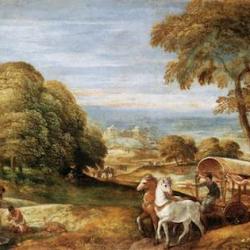MD Goulder (Type and History in Acts) points out that the history recorded in Acts doesn’t follow the Jerusalem-Judea-Samaria-ends of earth pattern that Jesus leads us to expect at the beginning of the book: “The four places are being given in their theological order: the holy city, the holy land, the seceded part of Israel, Gentiledom. Now this would be the natural order for St Luke to tell his story. Historically, however, things had gone slightly differently. The gospel had begun with the holy people, and had gone out by way of the Samaritans to the Gentiles in the way one would expect. But the vital bridge into Gentiledom had been at Caesarea, the capital ofJudea, with the conversion of Cornelius, and not at Samaria, as would have been more appropriate theologically. It would seem then as if the order should not be: Jerusalem, Judea, Samaria, the eschaton, but: Jerusalem, Samaria, Judea, the eschaton” (68).
Further disrupting the pattern is the fact that Gentile God-fearers are reached in each of the four locations. Peter preaches to a mixed crowd on Pentecost; Philip preaches not only to Samaritans but to the Ethiopian eunuch; Peter brings the gospel to Cornelius and his household; and of course Paul eventually journeys to Rome.
Each of these missions, though, is rooted in Jerusalem: “every fresh step forward begins from Jerusalem the whole way through the book. In Section I the action takes place in Jerusalem entirely. Section 11 describes how the word was taken to the periphery of Israel beginning at Jerusalem: for Stephen’s ministry is still in the capital, but as a direct consequence of his martyrdom,’they that were scattered abroad went everywhere preaching the word: then Philip went down to the city of Samaria . . .’ (8.4-5). The geographical sub-title to the section would be, ‘Jerusalem to Samaria, etc.’ Section Ill moves on to a new area of country in Judea. Lydda (9.32-5), Sharon (9.35), Joppa (9.36-end), Caesarea (10) are all towns inJudea, and provide the scene of Peter’s ministry, especially in the conversion of the first God-fearers to .the Church. But again the movement begins from Jerusalem, for from 9.26-3 I we are back with the Church in the holy city with Saul, Barnabas, and ‘the apostles’, and it is from there that Peter passes through all quarters and comes down to Lydda (9.32). The scene shifts again in Section IV to the cities of the Gentile world for the gathering in of the Gentiles at large: but again the new movement must begin from Jerusalem. Barnabas and Saul are in the capital with the famine-money from 11:29, and the scene is there for the whole ofPeter’ s passion in 12.” Even when the mission begins from Antioch, we’re reminded that Christians got to Antioch from Jerusalem (13:1; pp. 69-70).
The mission moves from city to city, in fact, from capital city to capital city: “We cannot help noticing the stress upon the different capitals. All the early history of the Church is lumped together in Jerusalem as the capital of Israel. Philip’s Samaritan ministry takes place in the city of Samaria. The conversion of Cornelius, being the central event of Ill, takes place at Caesarea, as the capital of Judea, and there also is the scene of Herod’s death which closes the section. The narrative of IV looks forward always to the preaching at Rome, as the capital of the world, and Rome is for St Luke representative of, and therefore equivalent to, the uttermost parts of the earth” (70).
The early mission is, in short, an urban mission movement, moving from city to city, and in each city reaching beyond the immediate audience to the ends of the earth.













